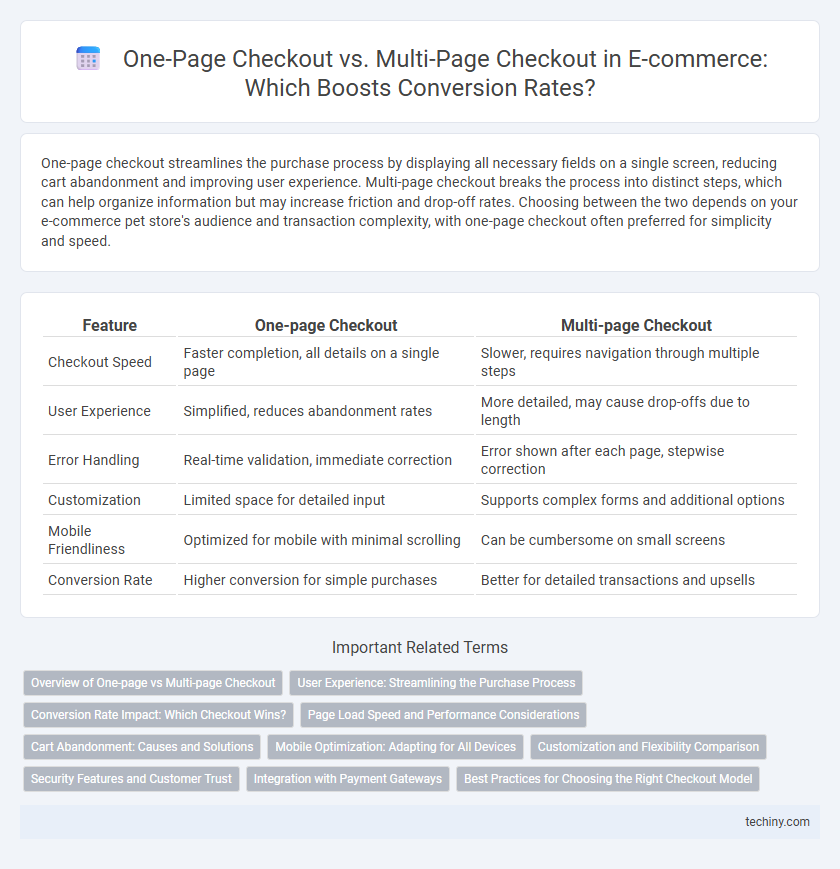One-page checkout streamlines the purchase process by displaying all necessary fields on a single screen, reducing cart abandonment and improving user experience. Multi-page checkout breaks the process into distinct steps, which can help organize information but may increase friction and drop-off rates. Choosing between the two depends on your e-commerce pet store's audience and transaction complexity, with one-page checkout often preferred for simplicity and speed.
Table of Comparison
| Feature | One-page Checkout | Multi-page Checkout |
|---|---|---|
| Checkout Speed | Faster completion, all details on a single page | Slower, requires navigation through multiple steps |
| User Experience | Simplified, reduces abandonment rates | More detailed, may cause drop-offs due to length |
| Error Handling | Real-time validation, immediate correction | Error shown after each page, stepwise correction |
| Customization | Limited space for detailed input | Supports complex forms and additional options |
| Mobile Friendliness | Optimized for mobile with minimal scrolling | Can be cumbersome on small screens |
| Conversion Rate | Higher conversion for simple purchases | Better for detailed transactions and upsells |
Overview of One-page vs Multi-page Checkout
One-page checkout consolidates all purchase steps into a single page, enhancing user experience by reducing friction and speeding up the transaction process. Multi-page checkout spreads the process across several pages, which can provide detailed information but often increases cart abandonment rates due to longer completion times. Studies show one-page checkouts can improve conversion rates by up to 20%, making them favorable for streamlined e-commerce performance.
User Experience: Streamlining the Purchase Process
One-page checkout enhances user experience by minimizing steps and reducing cart abandonment rates, allowing customers to complete purchases faster through a single, consolidated form. Multi-page checkout divides the process into clear stages, which can help organize information but may increase friction and drop-off rates due to longer navigation and perceived complexity. E-commerce businesses often prefer one-page checkouts to streamline purchase flow, improve conversion rates, and provide a seamless, efficient user experience.
Conversion Rate Impact: Which Checkout Wins?
One-page checkout significantly boosts conversion rates by streamlining the purchasing process and reducing cart abandonment through faster load times and simplified navigation. Multi-page checkout, while providing a more detailed and segmented user experience, risks losing customers at each step due to longer completion times and increased friction. Data shows that e-commerce sites implementing one-page checkout can see conversion rate improvements of up to 20%, making it the preferred option for maximizing sales.
Page Load Speed and Performance Considerations
One-page checkout enhances page load speed by consolidating all necessary fields into a single, streamlined interface, which reduces server requests and accelerates transaction completion. Multi-page checkout, while potentially more detailed, often suffers from slower performance due to multiple page reloads and increased latency, negatively impacting user experience. Optimizing server response time, minimizing scripts, and leveraging asynchronous loading techniques are crucial for maintaining high-performance checkout flows in both models.
Cart Abandonment: Causes and Solutions
One-page checkout reduces cart abandonment by streamlining the purchase process, minimizing steps, and providing a clear, concise interface that prevents user frustration. Multi-page checkout often causes higher abandonment rates due to lengthy navigation, increased load times, and overwhelming form fields that discourage completion. Optimizing forms, offering guest checkout, and providing visible progress indicators help alleviate friction in multi-page checkouts, boosting conversion and reducing abandoned carts.
Mobile Optimization: Adapting for All Devices
One-page checkout enhances mobile optimization by reducing page loads and minimizing friction, leading to faster transaction times and higher conversion rates on smartphones and tablets. Multi-page checkout can provide detailed user input fields but often causes mobile users to abandon carts due to longer loading times and complex navigation. Prioritizing a responsive, streamlined one-page design ensures a seamless e-commerce experience across all devices, catering to the increasing dominance of mobile traffic.
Customization and Flexibility Comparison
One-page checkout offers streamlined customization options by consolidating all purchase steps into a single interface, enabling users to modify shipping, payment, and promo codes without page reloads, enhancing flexibility and reducing cart abandonment. In contrast, multi-page checkout provides granular customization at each step, allowing tailored prompts and validation that cater to complex user needs or regulatory requirements, though it may slow the purchase process. E-commerce platforms must balance the one-page checkout's efficiency with the multi-page checkout's detailed control to optimize user experience and conversion rates.
Security Features and Customer Trust
One-page checkout streamlines the purchasing process by consolidating all payment and shipping information on a single page, incorporating robust SSL encryption and PCI DSS compliance to safeguard customer data, which enhances trust by minimizing the risk of data breaches. Multi-page checkout, while potentially more secure due to segmented data entry that reduces bot attacks, can introduce more opportunities for customer drop-off but allows for dedicated security verifications at each step, reinforcing confidence in transaction safety. Implementing visible trust badges, encrypted payment gateways, and clear privacy policies across both checkout types is crucial for maintaining customer confidence and driving higher conversion rates in e-commerce.
Integration with Payment Gateways
One-page checkout streamlines the payment process by integrating multiple payment gateway options within a single interface, reducing cart abandonment rates. Multi-page checkout allows for detailed verification steps but may require complex payment gateway integration across several pages, potentially increasing development time. Optimizing payment gateway APIs for seamless API calls in one-page checkout enhances faster transaction processing and a smoother user experience.
Best Practices for Choosing the Right Checkout Model
Optimizing e-commerce conversion rates hinges on selecting the appropriate checkout model tailored to target audience behavior and product complexity. One-page checkout streamlines the purchasing process by reducing friction and minimizing cart abandonment, ideal for stores with low SKU counts and returning customers. Multi-page checkout suits businesses with complex customization options or detailed billing requirements, enhancing data accuracy and perceived security for high-value transactions.
One-page Checkout vs Multi-page Checkout Infographic

 techiny.com
techiny.com